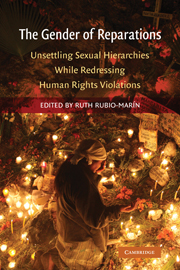Book contents
- Frontmatter
- Contents
- Acknowledgments
- Contributors
- Photo Credits: “Gender, Memorialization, and Symbolic Reparations,” in The Gender of Reparations
- International Center for Transitional Justice (ICTJ)
- Introduction: A Gender and Reparations Taxonomy
- 1 Gender and Violence in Focus: A Background for Gender Justice in Reparations
- 2 The Gender of Reparations in Transitional Societies
- 3 Reparation of Sexual and Reproductive Violence: Moving from Codification to Implementation
- 4 Reparations as a Means for Recognizing and Addressing Crimes and Grave Rights Violations against Girls and Boys during Situations of Armed Conflict and under Authoritarian and Dictatorial Regimes
- 5 Repairing Family Members: Gross Human Rights Violations and Communities of Harm
- 6 Tort Theory, Microfinance, and Gender Equality Convergent in Pecuniary Reparations
- 7 Gender, Memorialization, and Symbolic Reparations
- 8 Gender and Collective Reparations in the Aftermath of Conflict and Political Repression
- Index
- References
4 - Reparations as a Means for Recognizing and Addressing Crimes and Grave Rights Violations against Girls and Boys during Situations of Armed Conflict and under Authoritarian and Dictatorial Regimes
Published online by Cambridge University Press: 25 August 2009
- Frontmatter
- Contents
- Acknowledgments
- Contributors
- Photo Credits: “Gender, Memorialization, and Symbolic Reparations,” in The Gender of Reparations
- International Center for Transitional Justice (ICTJ)
- Introduction: A Gender and Reparations Taxonomy
- 1 Gender and Violence in Focus: A Background for Gender Justice in Reparations
- 2 The Gender of Reparations in Transitional Societies
- 3 Reparation of Sexual and Reproductive Violence: Moving from Codification to Implementation
- 4 Reparations as a Means for Recognizing and Addressing Crimes and Grave Rights Violations against Girls and Boys during Situations of Armed Conflict and under Authoritarian and Dictatorial Regimes
- 5 Repairing Family Members: Gross Human Rights Violations and Communities of Harm
- 6 Tort Theory, Microfinance, and Gender Equality Convergent in Pecuniary Reparations
- 7 Gender, Memorialization, and Symbolic Reparations
- 8 Gender and Collective Reparations in the Aftermath of Conflict and Political Repression
- Index
- References
Summary
I felt as if my heart had stopped beating, only God gave me the resistance to bear it all. I was very young, but I felt the hardship. …I still dream about Dos Erres and I hear everything I heard then, the shots, the smell, the air, everything.
The violence, abuse, and hardship that girls and boys suffer during armed conflict and political violence under authoritarian and dictatorial regimes ensures that they will never be the same when the war stops or the violent regime ends. Children's experiences of war and political violence – the abuse of their bodies, souls, and minds, the tearing apart of their families and neighborhoods, and the atrocities they witness – shape them and their societies. They experience violations of their civil, political, social, economic, and cultural rights. These include the rights to life, freedom of movement and association, education, health, and knowing and being cared for by their parents. Their rights to development and to a safe and healthy environment are also violated.
It is not possible to fully repair children after they have experienced such harms. It is not possible to recover the years of lost education, or the time that would have been spent developing emotional and spiritual ties to family, friends, and communities as well as the skills that enable children to take pride in contributing to their households' livelihoods.
- Type
- Chapter
- Information
- The Gender of ReparationsUnsettling Sexual Hierarchies while Redressing Human Rights Violations, pp. 162 - 214Publisher: Cambridge University PressPrint publication year: 2009
References
- 11
- Cited by

